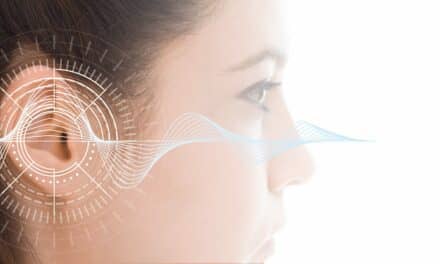Case Study | January 2019 Hearing Review
Patients presenting with sudden sensorineural hearing loss (SSNHL) may be thought of as one of the few true “emergencies of the ear” presented to hearing care professionals. Here is a case study that highlights the importance of the MRI when evaluating SSNHL.
Acoustic neuromas (AN), also known as vestibular schwannomas, are typically benign, slow-growing tumors on the VIII cranial nerve. Their incidence is approximately 1 in 100,000 people,1 and they are typically treated with surgery, CyberKnife, or watchful waiting. The vast majority are unilateral, the exception being Neurofibromatosis Type II. The symptoms—which include hearing loss, tinnitus, and vertigo or dizziness—are usually of gradual onset and may occur together or separately. They are best identified via magnetic resonance imaging (MRI) with possible visualization of tumors as small as 1 mm. Previously, auditory brainstem response (ABR) was used as a relatively inexpensive screening tool, however, it cannot always detect small tumors.2,3
Sudden sensorineural hearing loss (SSNHL) is typically described as a decrease of at least 30 dB at three or more frequencies that occurs within a brief time period. The majority are unilateral, and they may occur with tinnitus and vertigo or dizziness. The most effective treatment is oral and/or intratympanic injections of steroids, typically prednisone orally and dexamethasone via intratympanic (IT) injection. If a person presents for treatment within several weeks of the onset of symptoms, the chance of a full or partial recovery of hearing is much improved. In a large survey, approximately 59% show recovery after treatment.4 Some may recover spontaneously without treatment.
Dizziness or vertigo and/or tinnitus may occur separately or simultaneously with the SSNHL, bringing the patient in for evaluation fairly quickly, with the AN being discovered in the subsequent workup. There is extensive literature on AN and SSNHL occurring simultaneously, with over 100 citations listed in the PubMed database when “sudden sensorineural hearing loss” and “acoustic neuroma” are entered as keywords. SSNHL may occur as the initial symptom in 1-9% of acoustic neuromas.5 Berg et al6 reported 13% of patients operated on for acoustic neuromas had SSNHL. Berenholz et al7 reported an incidence up to 14% of acoustic neuromas presenting as SSNHL, while Ogawa et al8 reported 22%.
Case Study
A 51-year-old male nurse, chiropractor, and long-time surfer presented at the Kaiser Permanente South San Francisco Head and Neck Clinic with a 3-day history of a more severe hearing loss and tinnitus in his right ear. He had noted bilateral hearing loss and tinnitus for at least the past year. He denied vertigo, otorrhea, otalgia, or otologic surgeries.
His initial audiogram is shown in Figure 1. The right ear showed a moderate to severe high- frequency SNHL from 1500-8000 Hz. The left ear was normal. Word recognition scores were 84% and 92% for the right and left ear respectively.

Figure 1. Initial audiogram for 51-year-old patient who experienced sudden hearing loss in his right ear, and initially thought it was due to surfer’s ear. However, an MRI revealed a possible acoustic neuroma.
The HNS exam revealed a right external auditory canal that was 80% obstructed by exostoses. He felt the exostoses were worsening and was hearing an echo when people spoke. The patient initially had thought the hearing loss was due to his ear canal being blocked by exostoses (ie, “surfer’s ear”) which had occurred previously. His ear canals were cleaned prior to the hearing evaluation. The patient was initially treated with oral prednisone (10 mg for 7 days) and an IT injection. He subsequently returned in 5 days for a second IT injection. Two weeks later, he returned for a third IT injection. He was seen for a repeat audiogram in 4 weeks after the baseline evaluation. He reported a decrease in the tinnitus and an improvement in hearing in the right ear.
The follow-up audiogram (Figure 2) showed a mild high-frequency SNHL from 3000-6000 Hz and a moderate loss at 8000 Hz. This represented a 35-70 dB improvement in hearing in the right ear. Word-recognition scores improved to 96% from 84% in the right ear. They were unchanged at 92% in the left ear.

Figure 2. After treatment with oral prednisone and three intratympanic injections, the patient experienced a 35-70 dB improvement in the right ear.
After the initial audiogram, an MRI without contrast revealed a possible AN. It was repeated with gadolinium, and a mass of 7 x 10 x 7 mm extending into the cerebellopontine angle was revealed.
This case highlights the importance of an MRI when evaluating SSNHL. If the MRI had not been performed initially and the improvement in hearing was taken as being a classic SSNHL without any other pathologies being present, the AR would likely have been missed or the diagnosis would have been delayed.
The patient was referred to an otologist and neurosurgeon to discuss AN surgical options, as well as the removal of his exostoses. The MRI was repeated 6 months later and no change in the size of the AN was noted. The patient opted for watchful waiting regarding the AN.
About the Authors: Carl Croutch, AuD, is an audiologist at Kaiser Permanente Hearing Center in Daly City, Calif, and C. Michael Hall, AuD, is a clinical audiologist who lives in Walnut Creek, Calif, and is now retired from private practice.
CORRESPONDENCE can be addressed to HR or Dr Croutch at: [email protected]
Citation for this article: Croutch C, Hall CM. Acoustic neuromas and sudden sensorineural hearing loss: A case study. Hearing Review. 2019;26(1)[Jan]:22-23.
References
-
Kshettry VR, Hsieh JK, Ostrom QT, Kruchko C, Barnholtz-Sloan JS. Incidence of vestibular schwannomas in the United States. J Neurooncol.2015;124(2):223-228.
-
Don M, Kwong B, Tanaka C. Interaural stacked auditory brainstem response measures for detecting small unilateral acoustic tumors. Audiol Neurootol. 2012;17(1): 54-68.
-
Marangos N, Maier W, Merz R, Laszig R. Brainstem response in cerebellopontine angle tumors. Oto Neurotol. 2001;22(1):95-99.
-
Edizer DT, Çelebi Ö, Hamit B, Baki A, Yigit Ö. Recovery of idiopathic sudden sensorineural hearing loss. J Int Adv Otol. 2015;11(2):122-126.
-
Chow JM, Garcia J. Acoustic neuroma presenting as sudden hearing loss. Am J Otolaryngol.1985;6(2):115-119.
-
Berg HM, Cohen NL, Hammerschlag PE, Waltzman, SB. Acoustic neuroma presenting as sudden hearing loss with recovery. Otolaryngol Head Neck Surg. 1986;94(1):15-22.
-
Berenholz, LP, Eriksen C, Hirsh FA. Recovery from repeated sudden hearing loss with corticosteroid use in the presence of an acoustic neuroma. Ann Otol Rhinol Laryngol.1992;101(10):827-831.
-
Ogawa K, Kanzaki J, Ogawa S, Tsuchihashi N, Inoue Y. Acoustic neuromas presenting as sudden hearing loss. Acta Otolaryngol Suppl.1991;S487(111):138-143.






